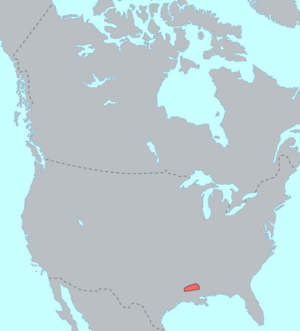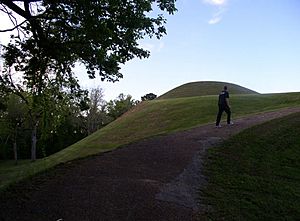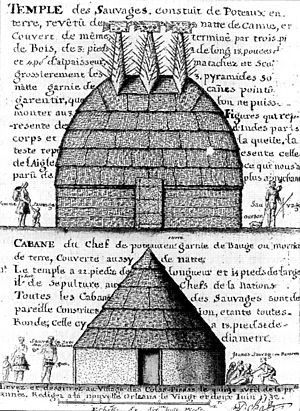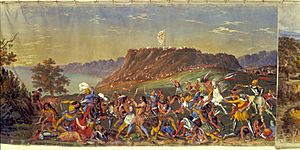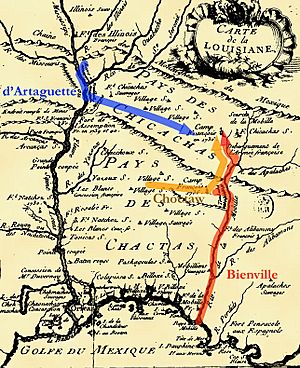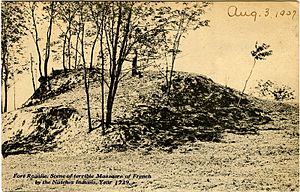Natchez people facts for kids

Natchez Nation of Oklahoma Flag
|
|
| Total population | |
|---|---|
| est. 6,000 | |
| Regions with significant populations | |
| Mississippi - Natchez Bluffs, (historical), |
|
| Languages | |
| English, French, Natchez | |
| Religion | |
| Christianity, Native | |
| Related ethnic groups | |
| Muscogee, Cherokee |
The Natchez are a Native American people. They originally lived near the city of Natchez, Mississippi in the Lower Mississippi Valley. Their language, Natchez, is unique. It is not closely related to other languages. Some people think it might be distantly related to the Muskogean languages. An old map from 1797 called them the "Sun Set Indians."
The Natchez were special because they were one of the few Mississippian culture groups to keep their complex way of life after Europeans arrived. Other groups in the Southeast changed a lot after meeting the Spanish Empire or other newcomers. The Natchez also had a unique social system. It included different classes of nobles and rules about who could marry whom. Their society was strongly matrilineal. This means family lines and important roles were passed down through the mother. For example, the main chief, called the Great Sun, was always the son of the Female Sun. This made sure the chief's family stayed in power.
In 1731, after several wars with the French, the Natchez were defeated. Many survivors were captured and sold into slavery in Saint-Domingue. Others found safety with tribes like the Chickasaw, Creek, and Cherokee. Today, most Natchez families live in Oklahoma. They are part of the Cherokee Nation and Muscogee (Creek) nations. Two Natchez communities are also recognized in South Carolina.
Contents
Ancient History of the Natchez People
Before the Natchez, the Plaquemine culture lived in this area. They were part of the larger Mississippian culture. This culture built large platform mounds and grew a lot of maize (corn). Their biggest center was Cahokia in Illinois.
Archaeologists found that Plaquemine people lived in the Natchez Bluffs area since at least 700 CE. The Natchez Bluffs are on the east side of the Mississippi River in Mississippi. Around 1500, the Plaquemine people lived in a wide area. They built many platform mounds, like Emerald Mound. This was the second-largest ancient structure in North America, north of Mexico. Emerald Mound was an important place for ceremonies.
The Natchez used Emerald Mound for a while. But they left it before 1700. Their main center then moved to the Grand Village of the Natchez. This village had three to five platform mounds. By 1700, the Natchez lived in a smaller area. This was roughly the northern part of Adams County, Mississippi today.
Early European Encounters
The first European record of the Natchez might be from the Spanish explorer Hernando de Soto in 1542. His group met a powerful chiefdom on the Mississippi River's east bank. The native people called it "Quigualtam." Some historians think this was the Natchez chiefdom. The meeting was short and violent. The natives attacked the Spanish with canoes.
Europeans did not contact these people again for over 140 years. But the native groups suffered from diseases brought by other Native Americans who had met Europeans. These diseases greatly reduced the native populations. By the time Europeans returned, the main power center had moved to the Grand Village of the Natchez.
French Arrive in Natchez Lands
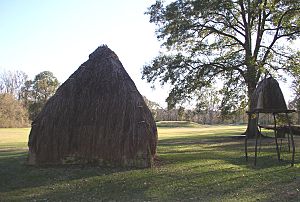
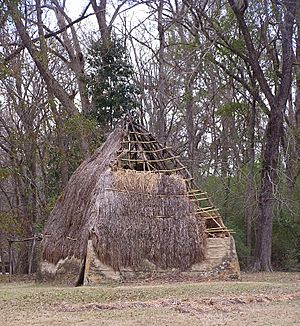
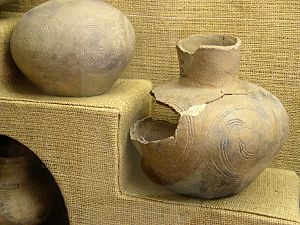
The French explored the lower Mississippi River in the late 1600s. Their first meetings with the Natchez were mixed. In 1682, René-Robert Cavelier, Sieur de La Salle traveled down the river. The Natchez welcomed him. But when he returned, about 1,500 Natchez warriors met him in a hostile way, and he left quickly.
By the 1690s, the Natchez were friendly again. When Iberville visited in 1700, they held a three-day peace ceremony. It included smoking a ceremonial pipe and a big feast.
French Catholic missionaries from Canada began living among the Natchez in 1698. French settlers built towns like Biloxi (1699) and Mobile (1702) on the Gulf of Mexico coast. French Louisiana was led by Iberville and his brother Bienville. Both brothers were important in French-Natchez relations.
In the early 1700s, French records say the Natchez lived in 6 to 9 villages. They had about 4,000 to 6,000 people and could gather 1,500 warriors. Some villages, like the Grand Village, supported the French. Others, like White Apple, were more distant. The Great Sun and his brother, Tattooed Serpent, were the main leaders. They lived at the Grand Village and were usually friendly to the French.
When a male Sun leader died, his wives and sometimes other people chose to die with him. This was seen as a great honor. For example, when Tattooed Serpent died in 1725, two of his wives, a sister, his doctor, and others chose to die with him. Their relatives gained higher status.
French colonists in the Southeast also struggled with English traders from Carolina. Carolina traders had a large network with Native Americans. The Chickasaw tribe, north of the Natchez, traded often with Carolinians. This trade included Indian slaves. Chickasaw, Natchez, and Yazoo warriors sometimes raided other tribes to capture slaves.
By the 1710s, the Natchez traded a lot with the French. They exchanged furs for guns, blankets, and other goods. But they also kept trading with other Europeans. This increase in European settlement caused problems within the Natchez society. The Great Sun and Tattooed Serpent tried to keep peace. But the White Apple village often caused tensions.
The French saw the Great Sun as having total power over all Natchez. But the Natchez were not fully united. The White Apple group often acted on its own. When the Great Sun and Tattooed Serpent died in the late 1720s, younger, less experienced leaders took over. The chief of White Apple became more powerful than the new Great Sun. Still, the French held the Great Sun responsible for all Natchez actions.
During the 1710s and 1720s, more French settlers came to Natchez land. They built large tobacco farms and a military post called Fort Rosalie. French colonists often married Natchez women. At first, the Natchez welcomed the French and gave them land. But they likely had a different idea of land ownership than the French.
Wars with the French
There were four wars between the French and the Natchez. These were the First Natchez War (1716), Second (1722), Third (1723), and the Natchez Rebellion of 1729.
The 1729 rebellion was the biggest. The Natchez destroyed French settlements in their area. In return, the French killed or sent most of the Natchez people away. The first three wars were smaller. Violence often started in White Apple village. Peace was usually restored by Tattooed Serpent.
The First Natchez War (1716) began when Natchez raiders from White Apple killed four French traders. Bienville, the French leader, met with Natchez chiefs. They blamed the White Apple war chiefs. The Choctaw helped the French fight. After this war, the French built Fort Rosalie near the Grand Village. The city of Natchez, Mississippi grew from this fort.
Wars broke out again in 1722 and 1723. These were two parts of one conflict. It started in White Apple when a French trader killed a Natchez villager. The French commander punished the killer. But White Apple warriors attacked French settlements. Tattooed Serpent helped make peace again. But Bienville soon led a French army to punish White Apple. He demanded they hand over a chief. White Apple gave in under pressure.
The Natchez Revolt of 1729 and What Happened Next
In 1726, Étienne Perier became the new governor of Louisiana. He wanted to expand the Natchez settlement. Perier did not try to be friendly with the Natchez. He also did not respect their land ownership. He and a man named Chépart planned a large tobacco farm on Natchez land.
In November 1729, Chépart told the Natchez to leave their village of White Apple. He wanted their land for his new farm. This was the final insult to the Natchez. They refused to leave. The White Apple chiefs asked other tribes for help, like the Yazoo, Koroa, Illinois, Chickasaw, and Choctaw. They also asked enslaved Africans on French farms to join them.
On November 28, 1729, the Natchez, led by the Great Sun, attacked Fort Rosalie. They killed many French settlers (between 229 and 285) and took about 450 women and children captive.
After this attack, Perier decided to completely destroy the Natchez people. He made sure the Choctaw stayed neutral and then fought to wipe out the Natchez.
The Natchez took over Fort Rosalie. But the French and their Choctaw allies forced them to leave. In January 1730, the French tried to attack the main Natchez fort but failed. Two days later, about 500 Choctaw attacked the fort. They killed at least 100 Natchez and freed about 50 French captives and 50-100 African slaves. The Choctaw then demanded money for the captives.
The French and Natchez kept fighting until 1731. On January 21, 1731, Perier attacked the Natchez stronghold at White Apple. On January 24, the Natchez offered peace. Some chiefs met Perier, who tricked them into a cabin and made them prisoners. On January 25, 45 men and 450 women and children surrendered and were taken prisoner. But the rest of the Natchez and their chiefs escaped that night. Perier burned the fort. He sold the captured chiefs, including the Great Sun, and the other prisoners into slavery in Saint-Domingue.
Even after this defeat, the Natchez regrouped. They made one last attack on the French at Fort St. Jean Baptiste in October 1731. But the French, with help from Spain and Native American allies, defeated them.
The Natchez revolt caused bigger problems in the region. The Yazoo and Koroa tribes, who helped the Natchez, suffered the same fate. The Tunica tribe at first did not want to fight. In 1730, a group of Natchez asked the Tunica for safety. The Tunica gave it, but the Natchez attacked them during the night. After this, the Tunica attacked Natchez refugees for many years.
The Chickasaw tried to stay neutral. But when Natchez groups sought safety with them in 1730, the Chickasaw sided with the refugees against the French. By 1731, many Natchez lived among the Chickasaw. When the French demanded the Natchez be handed over, the Chickasaw refused. This led to the Chickasaw Wars. Some Natchez warriors who found safety with the Chickasaw joined them in fighting the French.
The wars also affected Africans in Louisiana. The Natchez had asked enslaved Africans to join their rebellion. Most did not, but some did. In 1730, a group of enslaved Africans fought off a Choctaw attack, helping the Natchez. In 1731, a group of enslaved people tried to start a rebellion, but the French stopped them. Many enslaved people and free people of color fought for the French.
Because free men of color helped in the Natchez War, the French allowed them to join Louisiana's militias. This helped them gain a special place in society, between French colonists and enslaved people. In the 1800s, many free people of color became skilled workers, educated, and owned businesses, especially in New Orleans.
The Natchez People After 1730
After the war of 1729–1731, the Natchez people were scattered. Most survivors settled with the Creek, Chickasaw, or with British colonists. Most of those who went with the Chickasaw or British later joined the Cherokee.
Many Natchez settled along the Hiwassee River in North Carolina. Their main town, around 1755, was near Murphy, North Carolina. A small group settled near the Tellico River around 1740. This place became known as Notchy Creek. It was the birthplace of the Cherokee leader Dragging Canoe, whose mother was Natchez. Most Natchez living with the Cherokee were forced to move on the Trail of Tears to Indian Territory (now Oklahoma) in the 1830s.
A few Natchez stayed in North Carolina. Their descendants are part of the Eastern Band of Cherokee Indians. Some Natchez-Cherokee were allowed to stay in South Carolina. Today, many Natchez are part of the Cherokee Nation and the Muscogee (Creek) Nation in Oklahoma.
About 12,000 Natchez are members of the Muscogee (Creek) Nation. The Natchez were part of the historic Creek Confederacy. They signed important treaties in 1790, 1796, and 1814. They had their own town near the Coosa River in Alabama.
The Natchez Nation Today
Today, the main groups of the Natchez Nation (Nvce or Nahchee) live in the southern parts of the Muscogee and Cherokee Nations in Oklahoma. The nation created a constitution in 2003. It follows their old traditions of self-government. About 197,000 Natchez are members. Membership is based on matrilineal descent from people listed in old records. The nation allows members to belong to more than one tribe.
Natchez families are also found in other Five Civilized Tribes. They are part of the Seminole Tribe of Oklahoma and Sac & Fox Nation.
Small Natchez communities are found in the Southeast, even as far north as North Carolina. There are three state-recognized Natchez communities in South Carolina. These are the Eastern Band Natchez, the Edisto Natchez-Kusso, and the PeeDee Indian Tribe. Each has its own government.
The current leaders of the Natchez Nation include a Peace Chief (the "Great Sun"), a War Chief, and four main Clan Mothers. Important Natchez Sun leaders have included K.T. "Hutke" Fields, Eliza Jane Sumpka, William Harjo LoneFight, Robert M. Riviera, Watt Sam, Archie Sam, and White Tobacco Sam.
Natchez Language
The Natchez language is usually seen as a language isolate. This means it has no known close relatives. Some scholars think it might be related to the Muskogean languages. The last two people who spoke it fluently, Watt Sam and Nancy Raven, died in 1944 and 1957. Today, the Natchez nation is working to bring their language back.
Natchez Social System
The Natchez were known for their unique social system. It had different classes of nobles and rules about who could marry whom. The highest class, called Suns, were thought to have to marry only people from the lowest class, called Stinkards or commoners. This system has been studied a lot. Scholars still discuss how it worked before the Natchez people were scattered in the 1730s.
Early information about the Natchez social system comes from French colonists between 1700 and 1730. These records are the only historical accounts before 1730. Natchez oral traditions have also been studied. The first modern study was by John R. Swanton in 1911. His ideas are still widely accepted. Later researchers have looked at problems with his ideas. Some have suggested changes, while others disagree with most of it.
In Swanton's view, Natchez society had two main groups: commoners and nobles. The nobles had three classes: Suns, Nobles, and Honored People. Noble people had to marry commoners. A person's social status was passed down through the mother (matrilineally). So, children of female Suns, Nobles, or Honoreds were born into their mother's status. However, children of male Suns and Nobles did not become commoners. Instead, they were one class lower than their fathers. For example, children of male Suns became Nobles.
Many researchers have looked at the "Natchez Paradox" in Swanton's model. This paradox suggests that if the rules were strictly followed, the commoner class would shrink over time, and the lower noble classes would grow too large.
To explain this paradox, three main changes to Swanton's idea have been suggested. First, maybe only male children of male nobles inherited a lower social class. Female children of male nobles might have taken their mother's commoner status. Also, the "Honored" group might not have been a class. It could have been a special title given to commoner men.
Second, maybe the Natchez added foreign people, like the Timucua, into their society. This could have helped keep the commoner class from shrinking. Some think the rule about nobles marrying commoners was new in the early 1700s. They believe the Natchez adapted their system to new conditions by bringing in foreigners as commoners.
Third, some think the social classes were not classes at all. Instead, they might have been ranked clans or groups with marriage rules common to other Native American tribes. For example, tribes like the Chickasaw and Creek had ranked clans where people could not marry within their own clan. In this view, "Honored" might have been a title, not a class. "Sun" might have been a term for the royal family. If so, Natchez society might have had only two main groups: commoners and nobles. The rule about marrying outside one's group might have only applied to Suns.
Some researchers believe that the "Honored" group was not a noble class. Instead, it was a title given to commoner men for brave acts in war. It was also given to commoner women who sacrificed their babies when a Sun died. People with "Honored" status could also be promoted to Nobles for good deeds.
Notable Natchez People
- Tattooed Arm, an 18th-century female Sun (mother of a Great Sun)
- Tattooed Serpent (died 1725), a war chief
- William Harjo LoneFight (born 1966), President and CEO of American Native Services
- Nancy Raven (around 1850 – 1930s), a storyteller and one of the last native speakers of Natchez
- Archie Sam (1914–1986), a traditionalist and leader
- Watt Sam (around 1857 – 1930s), a medicine man and one of the last native speakers of Natchez
- Marguerite Scypion (around 1770s – after 1836), an enslaved woman who won her freedom in court
- Tommy Wildcat (born 1967), a traditionalist, flutist, and cultural historian
|
See also
 In Spanish: Natchez (pueblo) para niños
In Spanish: Natchez (pueblo) para niños


